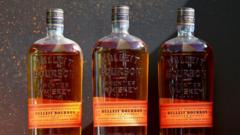Once enjoying a resurgence post-Great Recession, Kentucky bourbon now faces significant challenges, with sales dropping due to inflation, generational shifts in drinking habits, and trade tariff implications. Distilleries brace for potential further struggles amidst an oversupplied market.**
The Rollercoaster of Kentucky Bourbon: From Flourishing Sales to Sudden Decline**

The Rollercoaster of Kentucky Bourbon: From Flourishing Sales to Sudden Decline**
Economic pressures, changing consumer habits, and international trade tariffs have led to a downturn in Kentucky's renowned bourbon industry.**
Kentucky bourbon has traditionally been synonymous with American culture, enjoying a significant boom in popularity after the last Great Recession. However, recent economic fluctuations, exacerbated by a post-Pandemic world and looming trade tensions, are leading to a significant decline in its market share.
The history of bourbon dates back to the 18th century, but it wasn’t until 1964 that the U.S. Congress officially recognized it as a "distinctive product." For decades, however, the spirit faced a decline in popularity, often viewed as outdated. This changed after the 2008 recession when a surge in interest revitalized bourbon due to its mid-range pricing and a renewed focus on craft cocktails. New laws in 2013 also paved the way for a thriving collectible market for vintage bottles.
Sales boomed, with an impressive 7% global growth from 2011 to 2020, according to the IWSR. Bourbon became a valuable commodity, spurring casual drinkers to invest in bottles much like stocks. But this bubble was bound to burst. The pandemic's restrictions hit bars hard, and rising inflation prompted many consumers, especially among younger generations, to seek cheaper alternatives or abstain from alcohol altogether.
This downturn in consumer behavior has had tangible effects, with bourbon sales expectations declining to a mere 2% between 2021 and 2024, as indicated by ISWR data. The fallout from global tariffs established during Donald Trump's administration has only deepened the crisis, with retaliatory tariffs from Europe impacting sales significantly. Canada, which previously imported about 10% of Kentucky bourbon, has also halted American liquor imports, dealing a harsh blow to the industry.
The consequences of this decline are evident as major distilleries report significant drops in sales. Bulleit Bourbon's performance declined by 7.3% this fiscal year, while Wild Turkey's sales fell by 8.1%. Smaller operations are feeling the strain, with some, like LMD Holdings, having to file for bankruptcy shortly after launching their establishments.
Despite the challenging economic landscape, experts like Marten Lodewijks, president of IWSR, remain cautiously optimistic. They believe that adversity may spur innovation, just as the Scotch whiskey market evolved after a slump decades earlier. Some Canadian distilleries have begun to experiment with bourbon-making techniques, indicating a possible shift in the spirits landscape.
As Kentucky bourbon grapples with these multifaceted challenges, the industry watches closely for the next moves in a market that is both resilient and vulnerable. The question looms: can Kentucky bourbon weather this storm, or will further distilleries join the growing list of casualties?



















